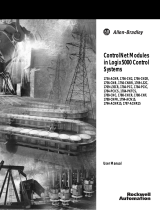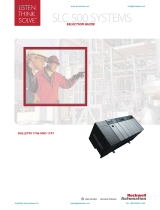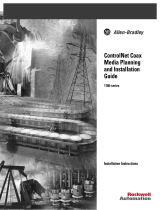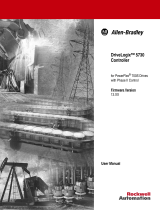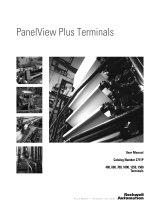Page is loading ...

Publication 1747-5.41
ControlNet Adapter Module
1747-ACN15, 1747-ACNR15
Installation Instructions
Inside...
For More Information .................................................................. 2
Module Description and Features............................................... 4
Hardware Components............................................................... 4
Determining Power Requirements.............................................. 6
Determining Power Requirements.............................................. 6
Installing the Adapter Module in the Chassis.............................. 7
Connecting Programming Terminals
to the Network via the NAP........................................................ 11
Powerup Sequence................................................................... 12
Troubleshooting With the Status Indicators and status Display 13
ControlNet Status Indicators..................................................... 17
Specifications............................................................................ 18
AB Spares

2
Publication 1747-5.41
For More Information
For detailed information on planning and installing your ControlNet system, see
the following publications:
If you would like a manual, you can:
• download a free electronic version from the internet:
www.theautomationbookstore.com
• purchase a printed manual by:
– contacting your local distributor or Rockwell Automation representative
– visiting
www.theautomationbookstore.com and placing your order
– calling
1.800.9NEWLIT(800.963.9548) (USA/Canada)
or
001.330.725.1574 (Outside USA/Canada)
Publication Publication Number
ControlNet Cable System Component List AG-2.2
ControlNet Cable System Planning and Installation Manual 1786-6.2.1
ControlNet Coax Tap Installation Instructions 1786-2.3
ControlNet Network Access Cable Installation Instructions 1786-2.6
ControlNet Repeater Installation Instructions 1786-2.7
Industrial Automation Wiring and Grounding Guidelines 1770-4.1
ControlNet Adapter User Manual 1747-6.24

3
Publication 1747-5.41
Compliance to European Union Directives
If this product has the CE mark, it is approved for installation within the
European Union and EEA regions. It has been designed and tested to meet the
following directives.
EMC Directive
This product is tested to meet Council Directive 89/336/EEC Electromagnetic
Compatibility (EMC) and the following standards, in whole or in part,
documented in a technical construction file:
• EN 50081-2
• EMC - Generic Emission Standard, Part 2 - Industrial Environment
• EN 50082-2
• EMC - Generic Immunity Standard, Part 2 - Industrial Environment
This product is intended for use in an industrial environment.
Low Voltage Directive
This product is tested to meet Council Directive 73/23/EEC Low Voltage, by
applying the safety requirements of EN 61131-2 Programmable Controllers, Part
2 - Equipment Requirements and Tests.
For specific information required by EN 61131-2, see the appropriate sections in
this publication, as well as the following Allen-Bradley publications:
• Industrial Automation Wiring and Grounding Guidelines For Noise
Immunity, publication 1770-4.1
• Automation Systems Catalog, publication B111
AB Spares

4
Publication 1747-5.41
Module Description and Features
The 1747-ACN15 and -ACNR15 adapters control 1746 remote I/O on the
ControlNet network. The ControlNet network is a communication architecture
that allows the exchange of messages between ControlNet products compliant
with the CI specification.
1747-ACN15 and 1747-ACNR15 adapters support multiple connections to
individual modules or rack connections to a group of modules. Up to 64
connections per adapter are possible with 255 words (max.) supported per
connection. Multiple connections per module are allowed for modules with large
M0 and M1 files. An adapter can control up to 30 slots of 1746 I/O (3 chassis
max.).
The 1747-ACN15 and -ACNR15 adapters features include:
• high speed data transfer
• diagnostic messages
• local communication network access through the network access port
(NAP)
• redundant media (1747-ACNR15 only)
Hardware Components
The adapter module consists of the following major components, as shown in the
following figure:
• ControlNet status and health indicators
• status display and network address
• network access port (NAP)
• ControlNet connectors (one on 1747-ACN15; two on 1747-ACNR15)
• module net address switch assemblies (on top of module)

5
Publication 1747-5.41
Figure 1 ControlNet Adapter Module
Diagnostic Indicators
Health indicators are located on the front panel of the adapter module (Figure 1).
They show both normal operation and error conditions in your remote I/O
system.
In addition, an alphanumeric display (net address/status) provides status code
indications when an error occurs during initialization or operation.
A complete description of the diagnostic indicators and status display and how to
use them for troubleshooting is explained on page 13.
Network Access Port (NAP)
The network access port (Figure 1) provides a bidirectional electrical interface
for programming, maintenance, and I/O monitoring devices in both redundant
and non-redundant connections. Connecting programming terminals to the
network using the NAP is described on page 11.
ADDRESS/STATUS
ADDRESS/STATUS
B
A
A
A
A
B
OK OK
Module Network Address Switches
(accessible thru top of module)
Health Indicators
ControlNet Status Indicators
Diagnostic Indicators
Network Access Port (NAP)
1747-ACNR15
ControlNet Media Port (A)
ControlNet Redundant Media Port (B) (1747-ACNR15 only)
1747-ACN15
Status Display and
Net Address
AB Spares

6
Publication 1747-5.41
ControlNet Connectors
Cable connection to the module is through standard BNC connectors on the
module frontplate, as shown below.
Figure 2 Cable Connections.
1. End device supporting redundant cabling is a 1747-ACNR15.
Refer to the ControlNet Cable System Planning and Installation User Manual,
Publication 1786-6.2.1 for more information.
Network Address Switch Assemblies
You must set two switch assemblies to configure your adapter module with its
unique network address. You access these switches through the top of the
module. Figure 3 shows the location of the switches. These switches are read on
power-up to establish the network address of the module. Network address
switch settings are described on page 7.
Determining Power Requirements
The ControlNet adapter module requires a maximum backplane current of
900mA at 5V dc. Remember to add this amount to other current requirements for
your I/O chassis.
B
A
Example of a Redundant System
trunkline A =
trunkline B =
Ter minator
Terminator
PLC-5/20C or
PLC-5/04C
end device
1

7
Publication 1747-5.41
Setting the Network Address Switches
The switches on the top of the adapter module determine the network address of
the adapter. The two switches are:
• the ten’s switch
• the one’s switch
The combination of these switches allows selection of network addresses from 01
to 99.
Figure 3 Setting the Network Address
Installing the Adapter Module in the Chassis
Once you’ve set the appropriate switch assemblies for your adapter module,
follow these procedures for installation.
Refer to the Industrial Controller Wiring and Grounding Guidelines publication
1770-4.1 for proper grounding and wiring methods to use when installing your
module.
Note:
00 is an invalid number.
!
ATTENTION: Remove system power before removing or
installing your module in the I/O chassis. Failure to observe
this warning could damage module circuitry and injure
people.
Ten’s
Selection
One’s
Selection
AB Spares

8
Publication 1747-5.41
1. Remove power from the I/O chassis before inserting (or removing) the
module.
2. Align the circuit board with the chassis card guide in the left slot.
Figure 4 Module Installation
3. Slide the module into the chassis until the top and bottom latches are
latched. To remove the module, press the releases at the top and bottom of
the module and slide it out.
4. Press firmly and evenly to seat the module in its backplane connectors.
Connecting Your Adapter to the ControlNet Network
You connect your 1747-ACN15 or -ACNR15 adapter module to a ControlNet
network via taps. These taps are available:
!
ATTENTION: Do not force the module into the backplane
connector. If you cannot seat the module with firm pressure,
check the alignment. Forcing the module can damage the
backplane connector or the module.
Latch
Card Guide
Power
Supply

9
Publication 1747-5.41
Figure 5 Available Taps
1. Remove the tap’s dust cap (located on the straight or right angle connector).
Figure 6 Connecting to a Tap
Important:
Taps contain passive electronics and must be purchased from
Allen-Bradley for the network to function properly.
If your node supports: Connect the tap’s straight or right angle connector:
Non-redundant media
to the channel A connector on the 1747-ACN15 or 1747-
ACNR15 (channel B on the 1747-ACNR15 is not used)
1
1. While both channels are active, Allen-Bradley recommends using channel A for non-redundant
media.
Redundant media
•from trunkline A to channel A on the 1747-ACNR15
•from trunkline B to channel B on the 1747-ACNR15
!
ATTENTION: Do not allow any metal portions of the tap to
contact any conductive material. If you disconnect the tap
from the adapter, place the dust cap back on the straight or
right angle connector to prevent the connector from
accidentally contacting a metallic grounded surface.
Straight T-tap
Straight Y-tap
Right-angle T-tap Right-angle Y-tap
1766-TPS 1786-TPYS
1786-TPR
1786-TPYR
segment 1
Tap
dust cap
AB Spares

10
Publication 1747-5.41
2. Remove and discard the dust caps from the adapter BNC jacks.
3. Connect this tap’s straight or right angle connector to the BNC connector on
the adapter.
Figure 7 Connecting to a Module
4. For redundant adapters (1747-ACNR15), remove (and save) the dust cap
located on the straight or right angle connector of the designated tap on the
second segment (segment 2).
Figure 8 Connecting a Redundant Adapter
5. Connect this tap’s straight or right angle connector to the BNC connector on
the adapter.
segment 1
tap
.
Important:
To prevent inadvertent reversal of the
top connections (resulting in incorrect
LED displays and troubleshooting),
check the tap drop cable for a label
indicating the attached segment before
making your connection.
segment 2
tap
dust cap

11
Publication 1747-5.41
Figure 9 Connecting the Redundant Module
6. After terminating your segments, connect the node to the network.
Connecting Programming Terminals to the Network via the NAP
You can connect programming terminals to the ControlNet network by
connecting to the network access port (NAP). Two methods are shown below.
Figure 10 Connecting to a Network
!
ATTENTION: Use the 1786-CP cable when connecting a
programming terminal to the network through NAPs. Using a
commercially available RJ-style cable could result in
possible network failures.
segment 1
tap
segment 2
tap
Using 1784-KTC or -KTCx communication
card and NAP
Programming
Te r m i na l
1784-KTC or
-KTCx
1786-CP
1
ControlNet
product
ControlNet network
Using 1770-KFC communication
interface and NAP
Programming
Terminal
Serial or Parallel
Connection
ControlNet Network
1. The 1786-CP cable can be plugged into any ControlNet product’s NAP to provide
programming capability on the ControlNet network. A programming terminal connected
through this cable is counted as a node and must have a unique address.
1786-CP
1
1770-KFC
ControlNet
product
AB Spares

12
Publication 1747-5.41
Powerup Sequence
There are three health indicators on the module. The LED on the right (labeled
“OK”) is the generic module health indicator. The LED in the middle (labeled
“A”) is the health indicator for cable A. On the 1747-ACNR15, the LED on the
left (labeled “B”) is the health indicator for cable B. In addition, the
alphanumeric display can display module status. The following describes the
normal power-up sequence for the adapter module.
1. Apply power to the chassis - notice that all three health indicators should be
off and the status window indicates “POST” (Power On Self Test).
2. After “POST”, the status window displays the sequence “0000”, “1111”,
“2222”, through “9999”. During this time, the A and B LEDs are off and
the OK LED appears amber.
3. The series and revision levels are then displayed in the status window. A
series A revision level B module would display “A/B”. During this time, the
A and B LEDs are off and the OK LED appears amber.
4. The status window then displays “INIT”, indicating that the operating
system is being loaded and initialized. During this time, the A and B LEDs
are off and the OK LED appears amber.
5. After the operating system is loaded and initialized, the status window and
the LEDs indicate the status of the module and its connections to the
cable(s). If the module address is not zero and a valid ControlNet
connection is made to either channel A or B, then the status window toggles
between “ACTV” (Active) and the module node address (“A#02” equals
node address number 2).
ADDRESS/STATUS
B
A
OK
Status
Health Indicators
Channel A and B
indicators

13
Publication 1747-5.41
Troubleshooting With the Status Indicators and status Display
The module has indicators on the front plate, as shown below. These indicators
consist of:
• health indicators
• status indicators
• display of status and address
Use these indicators for troubleshooting the module.
Figure 11 Indicators
The following tables describe problems that may occur, probable causes, and
recommended courses of action.
Health Indicators and Display Mnemonics
OK LED Display Description Probable Cause
Recommended
Action
Off None
Module is not
communicating.
Power supply
fault.
Check power supply,
and seat adapter
firmly in chassis.
Off None
Module is not
communicating.
Defective adapter.
Contact Allen-
Bradley service.
Off POST
Adapter is
running Power
On Self Test.
None None
ADDRESS/STATUS
ADDRESS/STATUS
B
A
A
A
A
B
OK OK
Status Display and
Net Address
Health Indicators ControlNet
Status Indicators
1747-ACN15
1747-ACNR15
AB Spares

14
Publication 1747-5.41
Amber
0000
through
9999
Adapter is
running Power
On Self Test.
None None
Amber A/A
Adapter is
displaying
Series and
Revision level.
None None
Amber INIT
Adapter is
loading and
initializing
operating
system.
None None
Solid Red
FATL
Number
Number
Module is not
communicating.
The Adapter has
either failed a
hardware test, or
gone into a state
from which it
cannot recover.
The two numbers
following the FATL
describe the
problem in detail.
Document the two
numbers. Power
cycle the adapter.
Contact Allen-
Bradley service.
Flashing
Green
PWR UP
Module is not
communicating.
The application
program in the
adapter has just
started.
None
Flashing
Red
A#00 ERR
Module is not
communicating.
The node address
switches are set to
00 which is not
valid.
Power the adapter
off, remove the
adapter from the
chassis, change the
node address switch
to something other
than 00, replace the
adapter in the
chassis, and apply
power.
Flashing
Red
NET ERR
Module is not
communicating.
The adapter has
not detected a
valid ControlNet
network on either
channel A or B.
Check ControlNet
cables.
OK LED Display Description Probable Cause
Recommended
Action

15
Publication 1747-5.41
Flashing
Red
WAIT ROGU
Module is not
communicating.
The adapter has
detected a cable
fault, and is
attempting to
recover. WAITing
to ROGUe is a
temporary state
which occurs just
before the adapter
sends the first of
three “I’m Alive!”
packets.
None, check cable if
problem persists.
Flashing
Red
I’M ALIV
Module is not
communicating.
The adapter has
detected a cable
fault and is
attempting to
recover. The
adapter is sending
the three “I’m
alive!” packets.
None, check cable if
problem persists.
Flashing
Red
DUP NODE
Module is not
communicating.
The adapter has
detected a
duplicated node
address on the
network.
Correct the
duplicate node
address problem.
Flashing
Green
CHEK MOD
Module is not
communicating.
The adapter has
detected a cable
fault and is
attempting to
recover. The
adapter has
detected the
moderator from an
active ControlNet
network.
None, check cable if
problem persists.
Flashing
Green
I’M ALIV
Module is not
communicating.
The adapter has
detected a cable
fault and is
attempting to
recover. The
adapter is sending
the three “I’m
alive!” packets.
None, check cable if
problem persists.
Solid Green ACTV A#XX
Module is
working
properly.
None None
OK LED Display Description Probable Cause
Recommended
Action
AB Spares

16
Publication 1747-5.41
Solid Green BOOT A#XX
Module is on
network, but not
supporting any
connections.
The main code in
the module has
failed, or the main
code is being
updated.
Update the main
code with the latest
Series and Revision
code.
Solid Green
CODE
UPDT
Firmware
update mode.
Adapter firmware
is being updated
via ControlFlash
update utility.
None
OK LED Display Description Probable Cause
Recommended
Action

17
Publication 1747-5.41
ControlNet Status Indicators
• steady - indicator is on continuously in the defined state.
• alternating - the two indicators alternate between the two defined states at
the same time (applies to both indicators viewed together). The two
indicators are always in opposite states, out of phase.
• flashing - the indicator alternates between the two defined states (applies to
each indicator viewed independent of the other). If both indicators are
flashing, they must flash together, in phase.
Cause Action
Off No power None or power up
Steady red Faulted unit
Cycle power
If fault persists, contact A-B representative or
distributor.
Alternating red/
green
Self-test None
Alternating red/
off
Incorrect node
configuration
Check network address and other ControlNet
configuration parameters
Cause Action
Off Channel disabled
Program network for redundant media, if
required
Steady green Normal operation None
Flashing green/
off
Temporary errors None; unit will self-correct
Listen only Cycle power
Flashing red/off Media fault
Check media for broken cables, loose
connectors, missing terminators, etc.
No other nodes present
on network
Add other nodes to the network
Flashing red/
green
Incorrect network
configuration
Cycle power or reset unit
If fault persists, contact A-B representative or
distributor.
B
A
and
B
A
or
AB Spares

18
Publication 1747-5.41
Specifications
Description Specification
Module Location 1746 I/O chassis, leftmost slot
Interconnect Cable
Quad shield RG-6 coaxial cable - Refer to the ControlNet
Cable System manual (pub. no. 1786-6.2.1) for more
information
Power Dissipation 5 Watts
Thermal Dissipation 17.06 BTU/hr
Backplane Current 900 mA @ 5V
Environmental Conditions
Operational Temperature
Storage Temperature
Relative Humidity
+0° to +60°C (+32° to +140°F)
-40°o to +85°C (-40° to +185°F)
5% to 95% (without condensation)
Agency Certification
(when product or packaging is
marked)
• UL listed
•C-UL listed
• Class I, Division 2, Groups A, B, C, and D
• CE marked for all applicable directives
(when product or packaging is marked)

Publication 1747-5.41 - March 1999 955138-74
1999 Rockwell International. All Rights Reserved. Printed in USA
AB Spares
/
